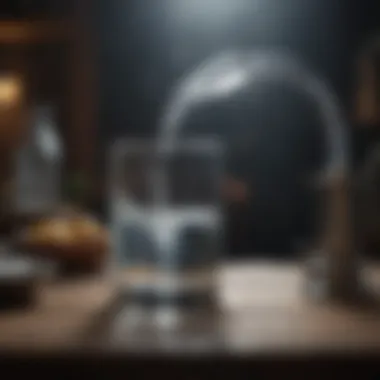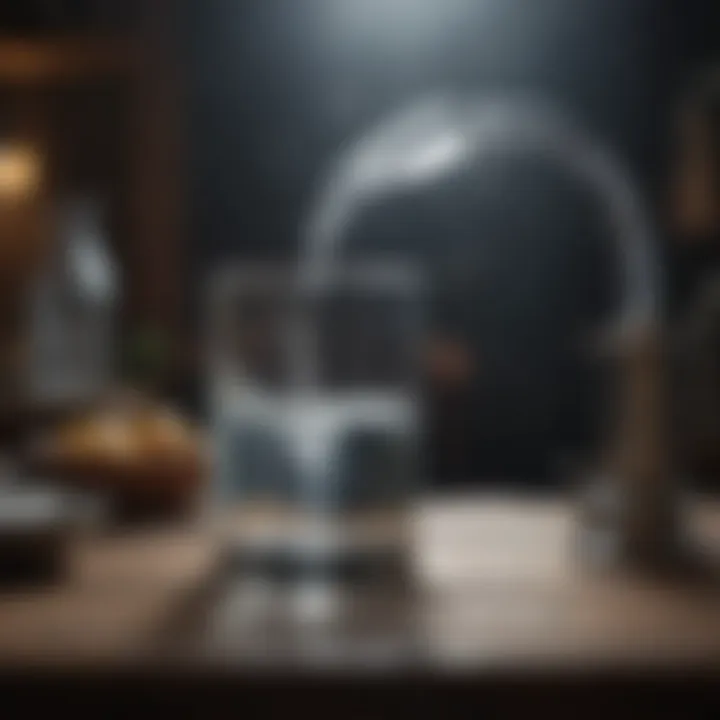Exploring Various Techniques for Purifying Water at Home


Overview of the Topic
Water purification at home is a crucial subject that pertains to the health and well-being of individuals in a domestic environment. Ensuring access to clean and safe drinking water within households is paramount for overall wellness. Various methods and techniques can be employed to purify water effectively and efficiently within the confines of one's home, mitigating potential health risks associated with contaminated water sources.
Current Status and Challenges
The current state of water quality in many areas poses significant challenges to obtaining safe drinking water at home. Pollution of water sources due to industrial waste, agricultural runoff, and inadequate sanitation systems contributes to the presence of harmful contaminants. Access to clean water remains a pressing issue for numerous communities, especially in regions where infrastructure for water purification is lacking or insufficient.
Sustainable Solutions
Exploring sustainable solutions for water purification entails utilizing innovative technologies and eco-friendly practices to address contamination issues. Implementing filtration systems, such as activated carbon filters and reverse osmosis systems, can effectively remove impurities from water. Additionally, incorporating rainwater harvesting, water recycling, and proper waste disposal methods can contribute to sustainable water management practices within households.
Impact and Importance


The impact of water purification extends beyond individual households to ecosystems, communities, and future generations. By ensuring access to clean drinking water, the prevalence of waterborne diseases can be reduced, promoting public health and well-being. Conservation efforts aimed at protecting water sources and implementing sustainable water purification methods are crucial for environmental preservation and the sustainability of natural resources.
Introduction to Home Water Purification
Water purification at home holds significant importance in ensuring access to clean and safe drinking water within domestic settings. In today's world where water pollution is a pressing issue, having the knowledge and means to purify water at home is crucial. This article aims to explore various methods of water purification that can be implemented in households. By understanding the different techniques available, individuals can take proactive steps towards safeguarding their health and well-being through access to safe drinking water.
Boiling Water
Basic Process of Boiling
The basic process of boiling water involves heating water to its boiling point, typically at 100 degrees Celsius. This method is widely recognized for its efficacy in killing harmful germs and bacteria present in water. By subjecting water to high temperatures, microorganisms that can cause diseases are eliminated, making the water safe for consumption. Boiling water is a simple yet effective way to ensure the purification of water, requiring minimal equipment and expertise.
Effectiveness in Removing Germs


Boiling water is highly effective in removing germs due to its ability to destroy the cellular structure of microorganisms. This ensures that waterborne pathogens are rendered inactive, reducing the risk of waterborne illnesses. The simplicity and accessibility of the boiling method make it a popular choice for water purification at home, especially in situations where other advanced technologies may not be available. While boiling effectively eliminates most germs, it is essential to note that certain contaminants like chemicals or heavy metals may not be removed through this process.
Using Water Filters
Types of Water Filters
Water filters come in various types, including activated carbon filters, reverse osmosis systems, and UV filters, each catering to specific purification needs. Activated carbon filters, for instance, rely on the adsorption process to trap impurities and chemicals present in water, providing enhanced taste and odor. Understanding the different types of water filters allows homeowners to choose the most suitable option based on their water quality requirements.
Mechanism of Action
The mechanism of action of water filters involves the physical or chemical removal of contaminants from water as it passes through the filter medium. For instance, reverse osmosis works by forcing water through a semipermeable membrane that blocks contaminants, while UV filters use ultraviolet light to deactivate microbes. By grasping how water filters operate, individuals can make informed decisions regarding the selection and maintenance of a filtration system that best suits their household's needs.
Other Effective Water Purification Methods


In the realm of ensuring safe drinking water within homes, exploring various methods of water purification becomes paramount. While the aforementioned techniques like boiling, using water filters, UV purification, ozonation, chlorination, and reverse osmosis hold their significance, other effective water purification methods widen the scope of accessible options. These additional methods provide alternative means to achieve clean and safe drinking water, offering diverse solutions to cater to different water quality concerns, making them valuable additions to the home water purification arsenal.
Granular Activated Carbon Filters
Adsorption Process
Granular activated carbon filters operate on the principle of adsorption, where contaminants in water are trapped on the surface of activated carbon. This process effectively removes impurities such as chlorine, volatile organic compounds, and other chemicals, enhancing water quality. The adsorption process is recognized for its efficiency in reducing harmful substances, making it a popular choice for water purification. Its ability to target a wide range of contaminants and improve the overall taste and odor of water underscores its importance in providing clean and palatable drinking water.
Reduction of Chemicals
Moreover, the reduction of chemicals through granular activated carbon filters plays a crucial role in enhancing water safety. By minimizing the presence of chemicals like chlorine and chloramine, these filters mitigate health risks associated with these substances, ensuring that the water consumed is free from potentially harmful elements. This reduction not only contributes to improving the taste and odor of water but also promotes overall well-being by offering a chemical-free drinking water solution, elevating the significance of granular activated carbon filters in the realm of home water purification.
Distillation
Heating and Condensation
In the distillation process, water is heated to produce steam, which is then condensed back into liquid form. This method effectively separates water from contaminants, minerals, and impurities, yielding a purer end product. The heating and condensation stages ensure the removal of pathogens, dissolved solids, and heavy metals, resulting in distilled water that is free from various pollutants. The meticulous nature of distillation in purifying water underscores its importance in producing high-quality drinking water at home.
Purity of the End Product
Furthermore, the purity of the end product in distillation serves as a hallmark of its effectiveness in water purification. The distilled water generated through this method boasts exceptional purity levels, devoid of impurities and contaminants present in the original water source. This unparalleled cleanliness and safety make distilled water a preferred choice for those seeking distilled water,



